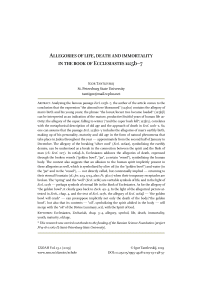Allegories of life, death and immortality in the book of Ecclesiastes 12:5b-7
Автор: Tantlevskij Igor
Журнал: Schole. Философское антиковедение и классическая традиция @classics-nsu-schole
Рубрика: Статьи
Статья в выпуске: 1 т.13, 2019 года.
Бесплатный доступ
Analyzing the famous passage Eccl. 12:5b-7, the author of the article comes to the conclusion that the expression "the almond tree blossomed" (12:5bα) contains the allegory of man’s birth and his young years; the phrase "the locust/locust tree became loaded" (12:5bβ) can be interpreted as an indication of the mature, productive/fruitful years of human life activity; the allegory of the caper, falling to winter ("and the caper bush fell"; 12:5bγ), correlates with the metaphorical description of old age and the approach of death in Eccl. 12:1b-2. So, one can assume that the passage Eccl. 12:5bα-γ includes the allegories of man's earthly birth, making up of his personality, maturity and old age in the form of natural phenomena that take place in Judea throughout the year - approximately from the second half of January to December. The allegory of the breaking "silver cord" (Eccl. 12:6aα), symbolizing the earthly demise, can be understood as a break in the connection between the spirit and the flesh of man (cf.: Eccl. 12:7). In 12:6аβ-b, Ecclesiastes adduces the allegories of death, expressed through the broken vessels ("golden bowl", "jar", a certain "vessel"), symbolizing the human body. The context also suggests that an allusion to the human spirit implicitly present in these allegories as well, which is symbolized by olive oil (in the "golden bowl") and water (in the "jar" and in the "vessel"), - not directly called, but contextually implied - returning to their eternal Fountain (cf.: Jer. 2:13, 17:13, also: Ps. 36:10) when their temporary receptacles are broken. The "spring" and the "well" (Eccl. 12:6b) are veritable symbols of life, and in the light of Eccl. 12:7b - perhaps symbols of eternal life in the Book of Ecclesiastes. As for the allegory of "the golden bowl", it clearly goes back to Zech. 4:2-3. In the light of the allegorical picture attested in Zech., chap. 4, and the text of Eccl. 12:7b, the allegory of Eccl. 12:6aβ - "the golden bowl will crack" - can presuppose implicitly not only the death of the body/"the golden bowl", but also that its contents - "oil", symbolizing the spirit abided in the body - will merge with the "oil" of the Divine Luminary, scil., with the Spirit of God.
Ecclesiastes, zechariah, chap. 3-4, allegory, symbol, life, death, immortality, youth, maturity, old age
Короткий адрес: https://sciup.org/147215816
IDR: 147215816 | DOI: 10.25205/1995-4328-2019-13-1-48-57
Список литературы Allegories of life, death and immortality in the book of Ecclesiastes 12:5b-7
- Abegg M., Jr., Flint P., Ulrich E., eds. (1999) The Dead Sea Scrolls Bible: The Oldest Known Bible Translated for the First Time into English. New York, NY: HarperCollins Publishers.
- Atkinson, T. (2015) Singing at the Winepress: Ecclesiastes and the Ethics of Work. London; New York, NY: Bloomsbury, T&T Clark.
- Bartholomew, C. (2009) Ecclesiastes. Ada, MI: Baker Academic Press.
- Battle I., Tous J. (1997) Carob tree. Rome: International Plant Genetic Resources Institute.
- Brown, W.P. (2011) Ecclesiastes: Interpretation. A Bible Commentary for Teaching and Preaching. Louisville, KY: Westminster John Knox Press.
- BW 2015 - BibleWorks 10. Software for Biblical Exegesis and Research. Norfolk, VA.
- CAD - The Assyrian Dictionary of the Oriental Institute of the University of Chicago. Vol. V. Chicago: The Oriental Institute of the University of Chicago, 1956.
- Dahood, M. (1952) "Canaanite-Phoenician Influence in Qoheleth", Biblica 33, 30-52, 191-221.
- Danin, A. (2010) "Capparis in the East Mediterranean countries", Flora Mediterranea. Vol. 20. Palermo: Luxograph, 179-185.
- Diakonoff, I.M. (1973) "The Book of Ecclesiastes", Poetry and Prose of the Ancient East. Moscow: "Khudozestvennaya Literatura" Publishing House, 638-652, 724-727 (in Russian).
- Duncan, J.A. (2017) Ecclesiastes. Nashville, TN: Abingdon Press.
- Enns, P. (2011) Ecclesiastes. Grand Rapids, MI: Eerdmans.
- Eswine, Z. (2014) Recovering Eden. The Gospel According to Ecclesiastes, Phillipsburg, NJ: R&P Publishing.
- KTU - Dietrich, M., Loretz O., Sanmartín J., eds. (1995) The Cuneiform Alphabetic Texts from Ugarit, Ras Ibn Hani and Other Places. 2nd, enlarged ed. Münster: Ugarit-Verlag.
- Lampe, G.W.H. (1961) A Patristic Greek Lexicon. Oxford: Clarendon Press.
- Levy, L. (1912) Das Buch Qoheleth. Leipzig: Hinrich’s.
- Moldenke, H.N. and A.L. (1952) Plants of the Bible. New York, NY: Ronald Press.
- OED - Simpson, J.A., Weiner, E.S., eds. (1989) The Oxford English Lexicon. 2nd ed. Vol. VIII. Oxford; New York: Oxford University Press.
- RES - Repertoire d'épigraphie sémitique: Académie des inscriptions et belles-lettres [cited by number].
- Seow, C.L. (1997) Ecclesiastes. A New Translation with Introduction and Commentary. Anchor Bible. New York, NY: Doubleday.
- Tantlevskij, I.R. (2014) "Optimism of Ecclesiastes", Voprosy Filosofii, 11, 137-148 (in Russian with an English abstract).
- Tantlevskij, I.R. (2017) "Possible Parallels in Ecclesiastes’ and Aristotle’s Reflections Concerning the Eternity and Immortality of the Soul in Correlation with Its Intellectual and Ethical Merits", ΣΧΟΛΗ (Schole), 11. 1, 133-143.
- Tantlevskij, I.R. (2018) "How to Come to the Correct Solution? To the Interpretation of the Epistemological Definition of the Method of Comparison in Aristotle (Ethica Eudemia, VII, 1245b.13-14) and Ecclesiastes 7:27", ΣΧΟΛΗ (Schole), 12. 1, 72-85 (in Russian with an English abstract).
- Uvarov, B. (1966-1977) Grasshoppers and Locusts. 2 vols. Cambridge: Cambridge University Press.
- Zohary, M. (1982) Plants of the Bible. Cambridge: Cambridge University Press.
- https://nsu.ru/classics/schole/13/13-1-tantl.pdf


